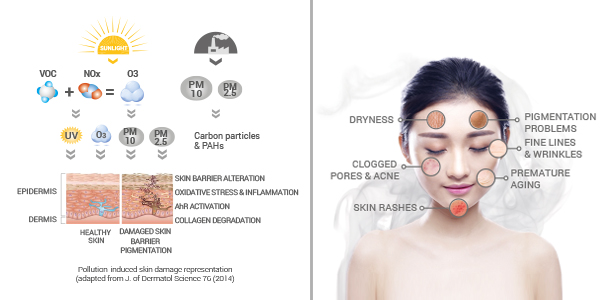Health
The Best Ways to Protect Your Skin from Air Pollution and Pollutants

Air pollution is a serious environmental issue that affects the quality of our lives in many ways. One of them being our skin. Several studies have identified a link between poor air quality in polluted cities and premature skin aging.
The key culprits include heavy metal emissions, exhaust fumes as well as cigarette smoke. These pollutants produce particles known as free radicals which can wreak havoc on your skin. When the level of free radicals exceeds the skin’s ability to combat them, the skin cells are placed in a state of oxidative stress. This state leads to skin sensitivity which may trigger various other skin issues like dull complexion and hyperpigmentation as well as premature aging.
As cities around the world are battling against poor air quality, the beauty industry has stepped up its game by adding “pollution protection” to skincare products in order to cleanse the skin alongside returning its radiant complexion and health. But what exactly are we protecting ourselves against?
What Are The Main Pollutants?
Sun Exposure
UV rays from the sun are a significant environmental factor and are recognized as a major threat to the skin. UV rays lead to the production of free radicals in the skin which can result in DNA damage. It leads to the breakdown of collagen and elastin, leading to the formation of fine lines and wrinkles. Sun exposure also stimulates the production of melanin which can lead to skin discoloration and even skin cancer.
Blue Light
Blue light or visible light is not necessarily a pollutant but is known to age skin. Blue light is a high-energy wavelength light that comes from computer screens and your cellular device. While research is still ongoing, studies have found that blue light causes free radical formation.
Air Pollution
Air pollution is a significant hazard in many cities – toxic particles from exhaust fumes such as carbon monoxide and nitrogen oxide being the main culprits. Particulate matter, hydrocarbons, and ozone are also significant pollutants contributing to skin damage and inflammation.
Particulate Matter (PM)
Particulate matter is a mixture of small particles with liquid droplets. Studies have shown that PM leads to skin inflammation and hinders the synthesis of collagen. Over time this leads to skin sagging, wrinkles and fine lines.
Ozone
Ozone is a toxic gas formed when mono nitrogen oxides interact with the UV rays of the sun. Ozone present in the stratosphere protects against these rays but ground-level ozone is toxic. The outer layer of our skin contains lipids. The ozone exposure oxidizes those lipids weakening the skin barrier leading to DNA damage and skin inflammation.
How Can You Protect Your Skin?
Sunscreen:
UV damage can easily be avoided by applying a good sunscreen. When purchasing one, make sure that the sunscreen is a broad-spectrum type so that it protects against both UV A and UV B rays. for Natural and hand made products check out Naturally Legit. That said, sunscreen does not protect against pollutants.
Invest in Antioxidants:
One of the best ways to combat environmental pollutants is to apply a serum containing two antioxidants: Vitamin E and Vitamin C. Vitamin E is a powerful antioxidant which, even when applied topically, helps fight off free radicals on the skin and protect it from damage. Combining vitamin E with vitamin C is even more effective than either of these vitamins alone.
Cleanse:
Yes! Keeping pollutants at bay can be as simple as washing your face with the right cleanser. Particulate matter and other harmful particles get attached to the skin but are not immediately damaging. Try to choose a cleanser that removes dead skin and grime without stripping your skin from its natural oils.
Moisturize:
Cleansing and exfoliating are essential but so is moisturizing. Always apply a serum or a cream loaded with active ingredients after cleansing or exfoliating your skin. Use serum and cream together as they complement each other and strengthen the skin’s protective barrier.
Chemical Peels:
A chemical peel can be an effective way to improve the appearance of skin exposed to sunlight and pollution. It exfoliates your skin, enhancing your skin’s complexion. Peels typically use AHAs (Alpha hydroxyl Acid), salicylic acid, and glycolic acid to remove the outer layer of skin. A light peel improves skin surface, lightens dark spots and evens out discolored skin.
Depending on the extent of skin damage, peels can range from light to medium. A medium chemical peel uses glycolic acid, trichloroacetic acid, and lactic acid to treat acne, sun damage and dry skin.
While at-home chemical peels exist, they typically contain lower concentrations of active ingredients compared to a professional treatment. For the best results, getting a chemical peel at a beauty clinic every once in a while is a great way to protect your skin from environmental damage and maintain a youthful complexion!
Bottom Line
To combat the effects of pollution, experts recommend a daily routine of cleansing, the use of antioxidants and barrier repair. Our best bet is in strengthening and keeping our skin healthy so it can fight off the pollutants’ radical damage by itself.































